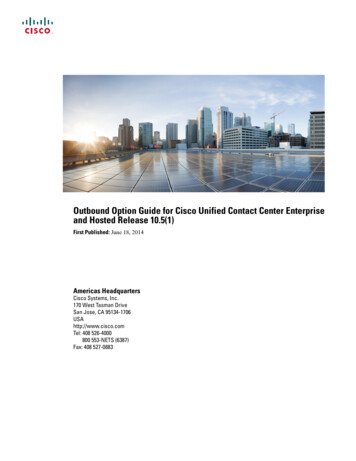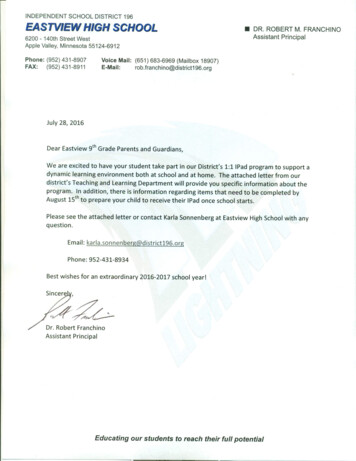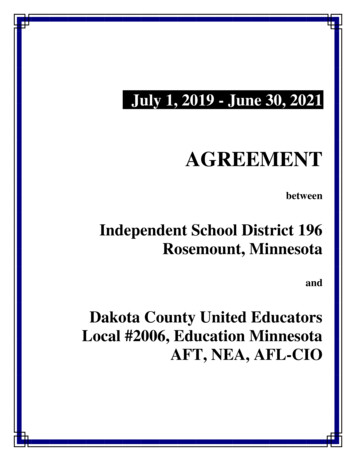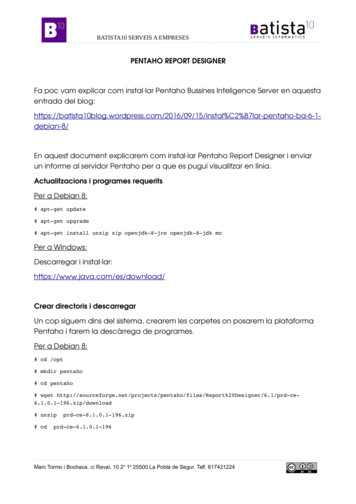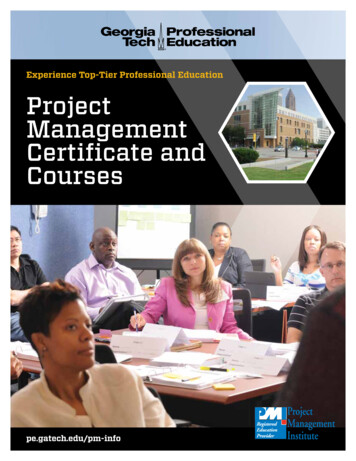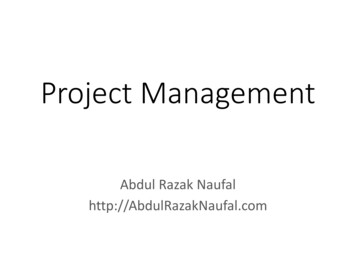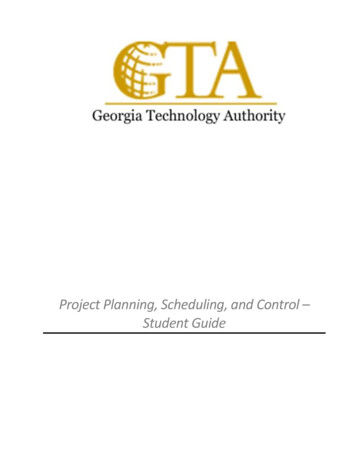
Transcription
Project Management InstituteConstructionExtension to A Guide to theProject ManagementBody of KnowledgePMBOK Guide—2000 EditionProvisional
ConstructionExtension toA Guide to theProject ManagementBody of Knowledge(PMBOK Guide) — 2000 Edition
ConstructionExtension toA Guide to theProject ManagementBody of Knowledge(PMBOK Guide) — 2000 EditionProject Management InstituteNewtown Square, Pennsylvania USA
ISBN: 1-930699-40-9Published by: Project Management Institute, Inc.Four Campus BoulevardNewtown Square, Pennsylvania 19073-3299 USAPhone: 610-356-4600 or Visit our website: www.pmi.orgE-mail: pmihq@pmi.org 2003 Project Management Institute, Inc. All rights reserved.“PMI”, the PMI logo and “PMBOK” are marks of the Project Management Institute, Inc.; “PMP” is a certification mark of the ProjectManagement Institute, Inc.PMI books are available at special quantity discounts to use as premiums and sales promotions, or for use in corporate trainingprograms as well as other educational programs. For more information, please write to the PMI Publishing, Bookstore Administrator,Four Campus Boulevard, Newtown Square, PA 19073-3299 USA, or e-mail booksonline@pmi.org. Or contact your local bookstore.Printed in the United States of America. No part of this work may be reproduced or transmitted in any form or by any means,electronic, manual, photocopying, recording, or by any information storage and retrieval system, without prior written permission ofthe publisher.The paper used in this book complies with the Permanent Paper Standard issued by the National Information StandardsOrganization (Z39.48—1984).10987654321
ContentsList of Figures . . . . . . . . . . . . . . . . . . . . . . . . . . . . . . . . . . . . . . . . . . . viiiPreface . . . . . . . . . . . . . . . . . . . . . . . . . . . . . . . . . . . . . . . . . . . . . . . . ixSection I—The Project Management Framework . . . . . . . . . . . . . . . . . . . . . .1Chapter 1—Introduction . . . . . . . . . . . . . . . . . . . . . . . . . . . . . . . . . . . . 31.1 Purpose of This Document . . . . . . . . . . . . . . . . . . . . . . . . . . . . 31.2 What Makes Construction Projects Unique? . . . . . . . . . . . . . . . . 41.3 What Is Project Management? . . . . . . . . . . . . . . . . . . . . . . . . . 51.4 Relationship to Other Management Disciplines . . . . . . . . . . . . . . 71.5 Related Endeavors-Programs of Projects . . . . . . . . . . . . . . . . . . . 7Chapter 2—The Project Management Context . . . . . . . . . . . . . . . . . . . . 92.1 Project Phases and the Project Life Cycle . . . . . . . . . . . . . . . . . . 92.2 Project Stakeholders . . . . . . . . . . . . . . . . . . . . . . . . . . . . . . . 122.3 Organizational Influences . . . . . . . . . . . . . . . . . . . . . . . . . . . . 122.4 Key General Management Skills . . . . . . . . . . . . . . . . . . . . . . . 132.5 Social-Economic-Environmental Influences . . . . . . . . . . . . . . . . 14Chapter 3—Project Management Processes . . . . . . . . . . . . . . . . . . . . 15Section II—The Project Management Knowledge Areas . . . . . . . . . . . . . . . .17Chapter 4—Project Integration Management . . . . . . . . . . . . . . . . . . . . 194.1 Project Plan Development . . . . . . . . . . . . . . . . . . . . . . . . . . . . 194.2 Project Plan Execution . . . . . . . . . . . . . . . . . . . . . . . . . . . . . . 214.3 Integrated Change Control . . . . . . . . . . . . . . . . . . . . . . . . . . . 22Chapter 5—Construction Project Scope Management . . . . . . . . . . . . . 255.1 Initiation . . . . . . . . . . . . . . . . . . . . . . . . . . . . . . . . . . . . . . . . 255.2 Scope Planning . . . . . . . . . . . . . . . . . . . . . . . . . . . . . . . . . . . 275.3 Scope Definition . . . . . . . . . . . . . . . . . . . . . . . . . . . . . . . . . . 285.4 Scope Verification . . . . . . . . . . . . . . . . . . . . . . . . . . . . . . . . . 305.5 Scope Change Control . . . . . . . . . . . . . . . . . . . . . . . . . . . . . . 31Chapter 6—Project Time Management . . . . . . . . . . . . . . . . . . . . . . . . 336.1 Activity Definition . . . . . . . . . . . . . . . . . . . . . . . . . . . . . . . . . . 336.2 Activity Sequencing . . . . . . . . . . . . . . . . . . . . . . . . . . . . . . . . 356.3 Activity Duration Estimating . . . . . . . . . . . . . . . . . . . . . . . . . . . 366.4 Schedule Development . . . . . . . . . . . . . . . . . . . . . . . . . . . . . . 366.5 Schedule Control . . . . . . . . . . . . . . . . . . . . . . . . . . . . . . . . . . 386.6 Activity Weights Definition . . . . . . . . . . . . . . . . . . . . . . . . . . . . .396.7 Progress Curves Development . . . . . . . . . . . . . . . . . . . . . . . . . .406.8 Progress Monitoring . . . . . . . . . . . . . . . . . . . . . . . . . . . . . . . . .41Chapter 7—Project Cost Management . . . . . . . . . . . . . . . . . . . . . . . . . 457.1 Resource Planning . . . . . . . . . . . . . . . . . . . . . . . . . . . . . . . . . 457.2 Cost Estimating . . . . . . . . . . . . . . . . . . . . . . . . . . . . . . . . . . . 477.3 Cost Budgeting . . . . . . . . . . . . . . . . . . . . . . . . . . . . . . . . . . . . 487.4 Cost Control . . . . . . . . . . . . . . . . . . . . . . . . . . . . . . . . . . . . . 48Chapter 8—Project Quality Management . . . . . . . . . . . . . . . . . . . . . . . 498.1 Quality Planning . . . . . . . . . . . . . . . . . . . . . . . . . . . . . . . . . . . 508.2 Quality Assurance . . . . . . . . . . . . . . . . . . . . . . . . . . . . . . . . . 528.3 Quality Control . . . . . . . . . . . . . . . . . . . . . . . . . . . . . . . . . . . . 53 2003 Project Management Institute, Four Campus Boulevard, Newtown Square, PA 19073-3299 USAv
Chapter 9—Project Human Resource Management . . . . . . . . . . . . . . . 559.1 Organizational Planning . . . . . . . . . . . . . . . . . . . . . . . . . . . . . . 569.2 Staff Acquisition . . . . . . . . . . . . . . . . . . . . . . . . . . . . . . . . . . . 589.3 Team Development . . . . . . . . . . . . . . . . . . . . . . . . . . . . . . . . 609.4 Project Team Closeout . . . . . . . . . . . . . . . . . . . . . . . . . . . . . . . .62Chapter 10—Project Communications Management . . . . . . . . . . . . . . 6510.1 Communications Planning . . . . . . . . . . . . . . . . . . . . . . . . . . . . 6510.2 Information Distribution . . . . . . . . . . . . . . . . . . . . . . . . . . . . . 6810.3 Performance Reporting . . . . . . . . . . . . . . . . . . . . . . . . . . . . . . 6910.4 Administrative Closure . . . . . . . . . . . . . . . . . . . . . . . . . . . . . . 71Chapter 11—Project Risk Management . . . . . . . . . . . . . . . . . . . . . . . . 7511.1 Risk Management Planning . . . . . . . . . . . . . . . . . . . . . . . . . . . 7511.2 Risk Identification . . . . . . . . . . . . . . . . . . . . . . . . . . . . . . . . . 7711.3 Qualitative Risk Analysis . . . . . . . . . . . . . . . . . . . . . . . . . . . . . 7911.4 Quantitative Risk Analysis . . . . . . . . . . . . . . . . . . . . . . . . . . . . 8011.5 Risk Response Planning . . . . . . . . . . . . . . . . . . . . . . . . . . . . . 8111.6 Risk Monitoring and Control . . . . . . . . . . . . . . . . . . . . . . . . . . 83Chapter 12—Project Procurement Management . . . . . . . . . . . . . . . . . 8512.1 Procurement Planning . . . . . . . . . . . . . . . . . . . . . . . . . . . . . . 8612.2 Solicitation Planning . . . . . . . . . . . . . . . . . . . . . . . . . . . . . . . . 8812.3 Solicitation . . . . . . . . . . . . . . . . . . . . . . . . . . . . . . . . . . . . . . 9212.4 Source Selection . . . . . . . . . . . . . . . . . . . . . . . . . . . . . . . . . . 9312.5 Contract Administration . . . . . . . . . . . . . . . . . . . . . . . . . . . . . 9512.6 Contract Closeout . . . . . . . . . . . . . . . . . . . . . . . . . . . . . . . . . 97Section III—The Construction Extension Unique Project Management KnowledgeAreas . . . . . . . . . . . . . . . . . . . . . . . . . . . . . . . . . . . . . . . . . . . .99Chapter 13—Project Safety Management . . . . . . . . . . . . . . . . . . . . . . .10113.1 Safety Planning . . . . . . . . . . . . . . . . . . . . . . . . . . . . . . . . . . 10113.2 Safety Plan Execution . . . . . . . . . . . . . . . . . . . . . . . . . . . . . . 10313.3 Safety Administration and Records . . . . . . . . . . . . . . . . . . . . . 105Chapter 14—Project Environmental Management . . . . . . . . . . . . . . . . .10714.1 Environmental Planning . . . . . . . . . . . . . . . . . . . . . . . . . . . . 10814.2 Environmental Assurance . . . . . . . . . . . . . . . . . . . . . . . . . . . 11214.3 Environmental Control . . . . . . . . . . . . . . . . . . . . . . . . . . . . . 114Chapter 15—Project Financial Management . . . . . . . . . . . . . . . . . . . . .11715.1 Financial Planning . . . . . . . . . . . . . . . . . . . . . . . . . . . . . . . . 11815.2 Financial Control . . . . . . . . . . . . . . . . . . . . . . . . . . . . . . . . . 12115.3 Financial Administration and Records . . . . . . . . . . . . . . . . . . . 122Chapter 16—Project Claim Management . . . . . . . . . . . . . . . . . . . . . . .12516.1 Claim Identification . . . . . . . . . . . . . . . . . . . . . . . . . . . . . . . 12516.2 Claim Quantification . . . . . . . . . . . . . . . . . . . . . . . . . . . . . . . 12716.3 Claim Prevention . . . . . . . . . . . . . . . . . . . . . . . . . . . . . . . . . 12816.4 Claim Resolution . . . . . . . . . . . . . . . . . . . . . . . . . . . . . . . . . 130Section IV—Appendices . . . . . . . . . . . . . . . . . . . . . . . . . . . . . . . . . . . . . .133Appendix A—The Project Management InstituteStandards-Setting Process . . . . . . . . . . . . . . . . . . . . . . 135Appendix B—Evolution of the Construction Extension . . . . . . . . . . . . 139Appendix C— Construction Extension Team . . . . . . . . . . . . . . . . . . . . 141Appendix D—Notes . . . . . . . . . . . . . . . . . . . . . . . . . . . . . . . . . . . . . . 143Appendix E—Application Area Extensions . . . . . . . . . . . . . . . . . . . . . 147Section V—Glossary and Index . . . . . . . . . . . . . . . . . . . . . . . . . . . . . . . . .151Glossary . . . . . . . . . . . . . . . . . . . . . . . . . . . . . . . . . . . . . . . . . . . . . . 153Index . . . . . . . . . . . . . . . . . . . . . . . . . . . . . . . . . . . . . . . . . . . . . . . . . 155vi 2003 Project Management Institute, Four Campus Boulevard, Newtown Square, PA 19073-3299 USA
List of FiguresFigure 1-1.Overview of Project Management Knowledge Areas and Project ManagementProcesses . . . . . . . . . . . . . . . . . . . . . . . . . . . . . . . . . . . . . . . . . . . . . . . 6Figure 1-2. Overview of Construction Unique Project Mangement Knowledge Areas andProject Management Processes . . . . . . . . . . . . . . . . . . . . . . . . . . . . . . . 7Figure 2-1a. Typical Design-Bid-Build Project Lifecycle . . . . . . . . . . . . . . . . . . . . . . . . 10Figure 2-1b. Typical Design-Build and Design-Build-Operate-Transfer Project . . . . . . . . 10Figure 3-1. Mapping of Project Management Processes and Construction ManagementProcesses to the Process Groups and Knowledge Areas . . . . . . . . . . . . . . 16Figure 8-1. Project Quality Management Overview . . . . . . . . . . . . . . . . . . . . . . . . . . 50Figure 10-1. Cost and Comparison to Estimate Report . . . . . . . . . . . . . . . . . . . . . . . . 71viii 2003 Project Management Institute, Four Campus tute,PA 19073-3299Four CampusUSABoulevard, Newtown Square, PA 19073-3299 USA
PrefaceIn 2002, PMI published the Government Extension to the PMBOK Guide- 2000 Edition. This fulfilled PMI's intent to supplement the informationin A Guide to the Project Management Body of Knowledge (PMBOK Guide)by providing industry-specific application area extensions. The Construction Extension to the PMBOK Guide is the second such application areaextension continuing PMI's intent to provide support to project management practitioners in specific industry areas. This extension is a supplementto the PMBOK Guide - 2000 Edition and should be used in conjunctionwith the PMBOK Guide - 2000 Edition.The PMBOK Guide describes the "generally accepted" knowledge andpractices applicable to most projects most of the time, upon which thereis widespread consensus about their value and usefulness. The Construction Extension to the PMBOK Guide describes knowledge and practicesthat are "generally accepted" for construction projects most of the time. Asan extension to the PMBOK Guide, there are limits on what can beincluded. These are:Chapters 1 through 3 (introduction, context, and processes): Specificsections of these chapters describe features that are particular to construction projects; otherwise you use the information in the PMBOK Guide 2000 Edition because it has equal value for construction projects.Chapters 4 through 12: Information is presented in one of two forms:A. Introduction: Describes features of the chapter's subject matter thatare particular to construction projects.B. Level 4 items: Apart from the introductions, changes to Chapters 4through 12 should be at level 4. (Examples: The first level 4 item inChapter 4 is 4.1.1.1 "Other Planning Outputs". The last level 4 item inChapter 12 is 12.6.3.2 "Formal Acceptance and Closure"). For each item: You may find no change to the information in the PMBOK Guide - 2000Edition and you will be referred back to the appropriate level 4 sectionof the PMBOK Guide - 2000 Edition. (If there are no changes to anyitems below level 2 you will be referred back to the appropriate level 2of the PMBOK Guide - 2000 Edition rather than going down to eachlevel 4.) You may find additional discussion or information about the existingPMBOK Guide - 2000 Edition level 4 item, describing features that areparticular to construction projects. You may also find new level 4 items that are particular to constructionprojects that are not found in the PMBOK Guide. And finally you may find that a particular level 4 item in the PMBOK Guide - 2000 Edition does not apply to construction projects. 2003 Project Management Institute, Four Campus Boulevard, Newtown Square, PA 19073-3299 USAix
The reader is alerted to these differences by reviewing the Inputs, Toolsand Techniques, and Outputs graphic in each section of the Chapters 4-12.THE PMBOK GUIDE - 2000 Edition Processes-inputs, tools andtechniques, and outputsThe PMBOK Guide - 2000 Edition describes the inputs, tools and techniques, and outputs of each project management process in Chapters 4 12. For each process it includes a table that lists these elements. This document includes similar tables. In each table, the elements have this format: Elements that remain unchanged from the PMBOK Guide - 2000 Edition are shown in plain text. New items are shown in Bold Italics. Changed elements are shown in Italics.Inputs.1.2.3.4.5Other planning outputsHistorical informationOrganizational policiesConstraintsAssumptionsUnchangedelementsset inRoman face.Tools & Techniques.1 Project planningmethodology.2 Stakeholder skillsand knowledge.3 Project managementinformation system(PMIS).4 Earned valuemanagement (EVM)Outputs.1 Project plan.2 Supporting detailChanged elementsset in ItalicsNew elementsset in Bold ItalicsThe Construction Extension to the PMBOK Guide also includes Construction Industry unique Knowledge Areas (Chapters 13 - 16) that are not inthe PMBOK Guide - 2000 Edition because they do not apply to most projects most of the time. These Construction Industry unique KnowledgeAreas are included in Section III.PMI is currently updating the PMBOK Guide - 2000 Edition and willpublish the PMBOK Guide - Third Edition in the Fall of 2004. In 2004, PMIwill begin an update project to align this provisional Construction Extensionto the PMBOK Guide - 2000 Edition to the PMBOK Guide - Third Edition.A Construction Extension to the PMBOK Guide - Third Edition will be available in 2005.x 2003 Project Management Institute, Four Campus Boulevard, Newtown Square, PA 19073-3299 USA
SECTION ITHE PROJECT MANAGEMENT FRAMEWORK1. Introduction2. The Project Management Context3. Project Management Processes
Chapter 1IntroductionA Guide to the Project Management Body of Knowledge (PMBOK Guide) 2000 Edition describes the principles of project management that are generally accepted for all types of projects. Throughout this document, A Guideto the Project Management Body of Knowledge will be referred to as thePMBOK Guide. All references are to the 2000 Edition.This extension is a supplement to the PMBOK Guide - 2000 Edition. Itdescribes the generally accepted principles for construction projects thatare not common to all project types. The general organization of knowledge areas and processes found in the PMBOK Guide - 2000 Edition arealso used in this extension to ease reference.This chapter defines and explains several key terms and provides anintroduction to the rest of the document. It includes the following majorsections:1.1 Purpose of this Document1.2 What Makes Construction Projects Unique?1.3 What is Project Management?1.4 Relationship to Other Management Disciplines1.5 Related Endeavors - Programs of Projects1.6 The PMBOK Guide - 2000 Edition Processes - Inputs, Tools andTechniques, and Outputs1.1 PURPOSE OF THIS DOCUMENTThe primary purpose of A Guide to the Project Management Body of Knowledge is "to identify and describe that subset of the PMBOK that is generally accepted."Appendix E of the PMBOK Guide - 2000 Edition describes applicationarea extensions. It says "Application area extensions are necessary whenthere are generally accepted knowledge and practices for a category of projects in one application area that are not generally accepted across the fullrange of project types in most application areas. Application area extensions reflect: 2003 Project Management Institute, Four Campus Boulevard, Newtown Square, PA 19073-3299 USA3
Chapter 1—Introduction Unique or unusual aspects of the project environment of which theproject management team must be aware in order to manage the projectefficiently and effectively. Common knowledge and practices that, if followed, will improve theefficiency and effectiveness of the project (e.g., standard work breakdown structures)."This is an application area extension for construction projects. The keycharacteristics of these projects are listed in Section 1.2.1.1.1 Why Is the Construction Extension Needed?It is true that much of the PMBOK Guide - 2000 Edition is directly applicable to construction projects. In fact, the practices and project managementof construction projects were one of the foundations of the original 1987document, The Project Management Body of Knowledge. Since that time, agrowing awareness of the values of project management to all kinds of projects and industries has led to a broadening of concepts and an inclusiveness that, because of its more universal nature, does not, in some respects;fully cover present-day project management practices found in the worldwide construction industry. For this reason, while the changes may not besubstantial, they are different enough from other industries and applications to warrant an extension.1.1.2 What Is the Goal of the Construction Extension?This extension aims to improve the efficiency and effectiveness of the management of construction projects and to include material specifically applicable to construction that is not presently covered in the PMBOK Guide 2000 Edition.1.2 WHAT MAKES CONSTRUCTION PROJECTS UNIQUE? 4Construction projects, with the possible exception of residential projects,do not produce a product as such; but rather a facility that will make orhouse the means to make a product or provide service facilities such asdams, highways and parks.They deal with geographical differences and natural events in every caseand may have a significant effect on the environment.Often, if not usually, they involve a team of hired specialists in designand construction disciplines.In today's world they have to involve many stakeholders, particularly,environmental and community groups that many other types of projectsdo not.Construction projects often require large amounts of materials and physical tools to move or modify those materials 2003 Project Management Institute, Four Campus Boulevard, Newtown Square, PA 19073-3299 USA
Chapter 1—Introduction1.3 WHAT IS PROJECT MANAGEMENT?See Section 1.3 of the PMBOK Guide - 2000 Edition. The nine knowledgeareas in the PMBOK Guide - 2000 Edition are all applicable to construction projects. However, in this extension, they have been modified toinclude certain aspects that are particular to the construction industry andto emphasize those activities that are of particular importance in construction. There are additional important knowledge areas for construction projects that may not apply to most other project managementactivities. They are: Safety Management, Environmental Management,Financial Management and Claim Management. While some aspects ofthese areas may be found in parts of the nine basic knowledge areas, theirimportance and universality in construction call for them to be treated asadded knowledge areas.1.3.1 The Project Management FrameworkSee Section 1.3.1 of the PMBOK Guide - 2000 Edition.1.3.2 The Project Management Knowledge AreasSee Section 1.3.2 of the PMBOK Guide - 2000 Edition. Four knowledgeareas particularly applicable to construction projects have been added:Chapter 13, Safety Management, describes the processes required toassure that the construction project is executed with appropriate care toprevent accidents that cause or have the potential to cause personal injuryor property damage.Chapter 14, Environmental Management, describes the processesrequired to ensure that the impact of the project execution to the surrounding environment will remain within the limits stated in legal permits.Chapter 15, Financial Management, describes the processes to acquireand manage the financial resources for the project and is more concernedwith revenue source and analyzing/updating net cash flows for the construction project than is cost management.Chapter 16, Claim Management, describes the processes required toeliminate or prevent construction claims from arising and for the expeditious handling of claims if they do occur. 2003 Project Management Institute, Four Campus Boulevard, Newtown Square, PA 19073-3299 USA5
Chapter 1—IntroductionPROJECTMANAGEMENT4. Project IntegrationManagement4.1 Project Plan Development4.2 Project Plan Execution4.3 Integrated Change Control7. Project CostManagement7.17.27.37.4Resource PlanningCost EstimatingCost BudgetingCost Control10. Project ions PlanningInformation DistributionPerformance ReportingAdministrative Closure5. Project ScopeManagement5.15.25.35.45.5InitiationScope PlanningScope DefinitionScope VerificationScope Change Control8. Project QualityManagement6. Project TimeManagement6.16.26.36.46.5Activity DefinitionActivity SequencingActivity Duration EstimatingSchedule DevelopmentSchedule Control9. Project HumanResource Management8.1 Quality Planning8.2 Quality Assurance8.3 Quality Control9.1 Organizational Planning9.2 Staff Acquisition9.3 Team Development11. Project RiskManagement12. Project ProcurementManagement11.111.211.311.411.511.6Risk Management PlanningRisk IdentificationQualitative Risk AnalysisQuantitative Risk AnalysisRisk Response PlanningRisk Monitoring and Control12.112.212.312.412.512.6Procurement PlanningSolicitation PlanningSolicitationSource SelectionContract AdministrationContract CloseoutFigure 1–1. Overview of Project Management Knowledge Areas and Project Management Processes6 2003 Project Management Institute, Four Campus Boulevard, Newtown Square, PA 19073-3299 USA
Chapter 1—IntroductionCONSTRUCTION UNIQUEPROJECT MANAGEMENTProjectSafetyroject Safety13. PManagementManagement14. Project EnvironmentalManagement13.1 Safety Planning13.2 Safety Plan Execution13.3 Administration and Reporting14.1 Environmental Planning14.2 Environmental Assurance14.3 Environmental Control15. Project FinancialManagement15.1 Financial Planning15.2 Financial Control15.3 Administration and Records13.16. Project ClaimManagement16.116.216.316.4Claim IdentificationClaim QuantificationClaim PreventionClaim ResolutionFigure 1–2. Overview of Construction Unique Project Management Knowledge Areas and Project ManagementProcesses1.4 RELATIONSHIP TO OTHER MANAGEMENT DISCIPLINESSee Section 1.4 of the PMBOK Guide - 2000 Edition.1.5 RELATED ENDEAVORS - PROGRAMS OF PROJECTSThe PMBOK Guide - 2000 Edition defines a program as "a group of projects managed in a coordinated way to obtain benefits not available frommanaging them individually." The Government Extension rightly says, "Programs are more common in the government than in the private sector."Still, construction is one of the main activities that governments use to carryout their programs. A current example is the management of the construction of a number of new schools in different geographical areas. Bytreating these as a program and awarding a contract to one firm (or thesame group of firms) for the management of all of the schools, the government is assured of a consistent approach and a single point of responsibility. The private sector may employ the same design and constructionteam to do several projects. These projects are not usually treated as a program, instead as individual projects done by the same group.The PMBOK Guide - 2000 Edition definitions of programs, subprojectsand portfolio management are also valid in the construction field. 2003 Project Management Institute, Four Campus Boulevard, Newtown Square, PA 19073-3299 USA7
Chapter 2The Project Management ContextThe PMBOK Guide - 2000 Edition advises, "Projects and project management operate in an environment broader than the project itself." Section1.2 describes some of the unique features of this environment for construction projects. Most of the content of this chapter listed in the five topicsin the PMBOK Guide - 2000 Edition is closely applicable to constructionprojects.2.1 PROJECT PHASES AND THE PROJECT LIFE CYCLEThe PMBOK Guide - 2000 Edition states "Organizations.will usually divideeach project into several project phases." This technique is particularlyimportant in a construction project where each phase has defined decisionpoints, deliverables or completion milestones which, when observed, provide a smooth flow and improved control over the life of the project.2.1.1Three Standard PhasesSee Section 2.1.1 of the PMBOK Guide - 2000 Edition.2.1.2 Characteristics of the Project Life CycleThis section of the PMBOK Guide - 2000 Edition generally defines thephases or stages for a construction project. The stages are shown in Figure2-3 of the PMBOK Guide - 2000 Edition. However, there are variations asthere are differences in the project delivery system. There are two primarydelivery systems: design-bid-build (DBB) and design-build.In design-bid-build, the owner or owner's agent produces a set of plansand specifications in sufficient detail that all competent contractors willhave a good understanding of what is required. A contract is awarded tothe lowest cost qualified bidder.In design-build, the owner or owner's agent produces a partial designand or a set of functional specifications and then hires a contractor to complete the design and construct the resulting project. Much of the design isperformed while construction is in progress. Further variations include 2003 Project Management Institute, Four Campus Boulevard, Newtown Square, PA 19073-3299 USA9
Chapter 2—The Project Management Contextbuild-operate-transfer (BOT), design-build-operate-maintain (DBOM) andother similar combinations.LegendPhase thatinvolves boththe Owner andthe ContractorPhase thatinvolves only theOwnerProjectProposalBidDesignBuildFigure 2–1a. Typical Design-Bid-Build Project LifecycleProjectProposalPartial Design Build Project LifecycleDesign-Build-Operate-Transfer Project LifecycleFigure 2–1b. Typical Design-Build and Design-Build-Operate-Transfer ProjectIn the context of project and construction management however, theportions of the contracted services that extend beyond the completion ofthe facility itself (i.e., maintenance or operation) are not considered apart of the management of a construction project. So, while such servicesmay be a part of contracted services, and certainly need to be carefullyconsidered, planned and executed, they take place in the field of"operations" and are not included in the body of knowledge related to themanagement of construction projects.2.1.3 Representative Project Life CyclesThis section of the PMBOK Guide - 2000 Edition includes a good summaryof the stages of a construction project and is depicted in Figure 2-3, LifeCycle Stages.When we think of a construction project we are usually referring to aproject not performed within a single organization, although those do existand are construction projects as well; but the more common type of construction project is one performed outside of the initiating organization bya team of specialists.The construction life cycle typically involves three main players; theowner, the designer and the constructor (contractor). Each plays a majorrole in a construction project although their responsibilities may vary widelydepending on the type of project plan and contract form selected.10 2003 Project Management Institute, Four Campus Boulevard, Newtown Square, PA 19073-3299 USA
Chapter 2—The Project Management ContextCommonly, the owner determines the need for a new facility or improvement and then performs, or has performed, a further study (often called afeasibility study) to more cle
Project Management Institute Newtown Square, Pennsylvania USA. ISBN: 1-930699-40-9 Published by: Project Management Institute, Inc. . Newtown Square, PA 19073-3299 USA ix. x 2003 Project Management Institute, Four Campus Boulevard, Newtown Square, PA 19073-3299 USA The reader is alerted to these differences by reviewing the Inputs, Tools

